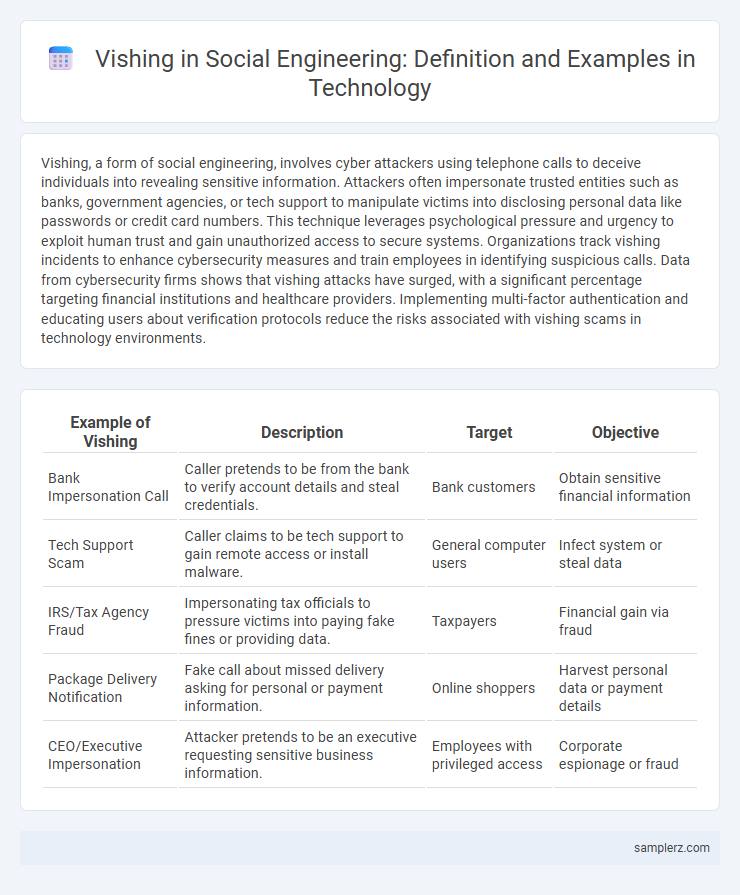Vishing, a form of social engineering, involves cyber attackers using telephone calls to deceive individuals into revealing sensitive information. Attackers often impersonate trusted entities such as banks, government agencies, or tech support to manipulate victims into disclosing personal data like passwords or credit card numbers. This technique leverages psychological pressure and urgency to exploit human trust and gain unauthorized access to secure systems. Organizations track vishing incidents to enhance cybersecurity measures and train employees in identifying suspicious calls. Data from cybersecurity firms shows that vishing attacks have surged, with a significant percentage targeting financial institutions and healthcare providers. Implementing multi-factor authentication and educating users about verification protocols reduce the risks associated with vishing scams in technology environments.
Table of Comparison
| Example of Vishing | Description | Target | Objective |
|---|---|---|---|
| Bank Impersonation Call | Caller pretends to be from the bank to verify account details and steal credentials. | Bank customers | Obtain sensitive financial information |
| Tech Support Scam | Caller claims to be tech support to gain remote access or install malware. | General computer users | Infect system or steal data |
| IRS/Tax Agency Fraud | Impersonating tax officials to pressure victims into paying fake fines or providing data. | Taxpayers | Financial gain via fraud |
| Package Delivery Notification | Fake call about missed delivery asking for personal or payment information. | Online shoppers | Harvest personal data or payment details |
| CEO/Executive Impersonation | Attacker pretends to be an executive requesting sensitive business information. | Employees with privileged access | Corporate espionage or fraud |
Common Vishing Scenarios in Social Engineering
Vishing commonly involves attackers impersonating bank representatives to extract sensitive financial information from victims. Another frequent scenario includes fraudsters posing as tech support agents to gain remote access to computers or steal login credentials. Criminals often use urgent, threatening messages to pressure targets into divulging personal details quickly.
Real-World Vishing Attack Examples
Real-world vishing attacks often exploit urgent tech support scams, where attackers impersonate legitimate companies like Microsoft to coerce victims into revealing sensitive information. In high-profile cases, fraudsters use spoofed phone numbers and convincing scripts to extract login credentials or payment details from unsuspecting employees. These attacks highlight the critical need for robust employee training and multi-factor authentication in protecting organizational data.
Vishing Tactics Targeting Businesses
Vishing tactics targeting businesses often involve attackers posing as trusted employees or IT personnel to extract sensitive information such as login credentials or financial data. These cybercriminals leverage social engineering techniques like urgent or threatening language to pressure victims into disclosing confidential details over the phone. Corporate sectors with minimal phone security protocols are particularly vulnerable to sophisticated vishing scams, leading to significant data breaches and financial losses.
Vishing Incidents in Financial Institutions
Vishing incidents in financial institutions often involve attackers impersonating bank officials to extract sensitive information such as account numbers, PINs, or one-time passwords from customers. These scams exploit trust and urgency, leveraging voice calls to deceive victims into transferring funds or divulging credentials. Recent reports indicate a significant rise in vishing attacks targeting high-net-worth individuals, resulting in multimillion-dollar losses and heightened security protocols across global banking networks.
Vishing Cases Exploiting Customer Support
Vishing cases exploiting customer support often involve attackers impersonating official representatives from banks or service providers to extract sensitive information such as account numbers and passwords from unsuspecting customers. These calls use social engineering tactics like urgency and trust to manipulate victims into revealing confidential data. Recent attacks show increased sophistication with fraudsters leveraging spoofed phone numbers and advanced voice modulation technologies to bypass caller ID verification systems.
Remote Work and Vishing Vulnerabilities
Remote work environments increase susceptibility to vishing attacks by exploiting employees' reliance on phone communication for sensitive information exchange. Cybercriminals impersonate IT support or management to extract login credentials or financial data through persuasive voice calls. These attacks leverage the lack of in-person verification and heightened urgency in remote settings to bypass security protocols.
Healthcare Sector Vishing Examples
Healthcare sector vishing attacks often involve scammers impersonating medical staff to obtain sensitive patient information or insurance details. Attackers use phone calls pretending to be from hospital administration or health insurance providers, exploiting urgency around appointments or billing issues. These tactics lead to unauthorized access to personal health information, causing data breaches and financial fraud within healthcare organizations.
Vishing Attempts Impersonating Government Agencies
Vishing attempts often impersonate government agencies such as the IRS or Social Security Administration to deceive victims into revealing sensitive personal information or making fraudulent payments. Attackers use caller ID spoofing and urgent messaging about tax audits or benefits suspension to create a sense of legitimacy and urgency. These sophisticated vishing scams exploit public trust in official institutions to manipulate individuals into compliance.
Vishing Attacks in Telecommunication Services
Vishing attacks in telecommunication services exploit voice communication to deceive individuals into divulging sensitive information such as login credentials or financial details. Attackers often impersonate legitimate institutions like banks or telecom providers, manipulating victims through persuasive phone calls to bypass security measures. These social engineering tactics significantly threaten personal data security and demand robust countermeasures including caller ID verification and employee training.
Lessons Learned from Vishing Case Studies
Vishing attacks exploit voice communication channels to deceive victims into revealing sensitive information, demonstrating the critical need for robust verification protocols and employee training. Case studies highlight the importance of multi-factor authentication and regular security awareness programs to mitigate risks posed by sophisticated vishing tactics. Organizations adopting proactive monitoring and incident response strategies have significantly reduced the success rate of vishing attempts.

example of vishing in social engineering Infographic
 samplerz.com
samplerz.com